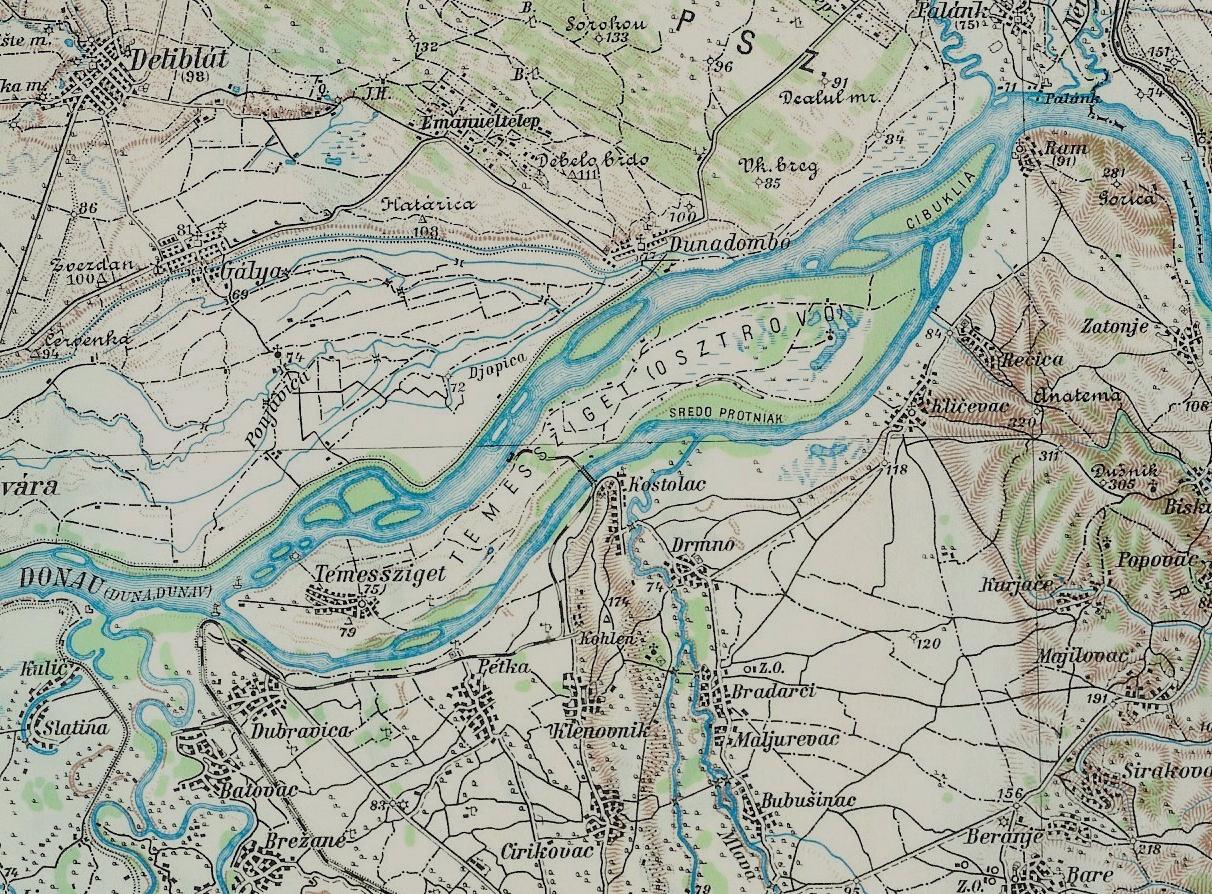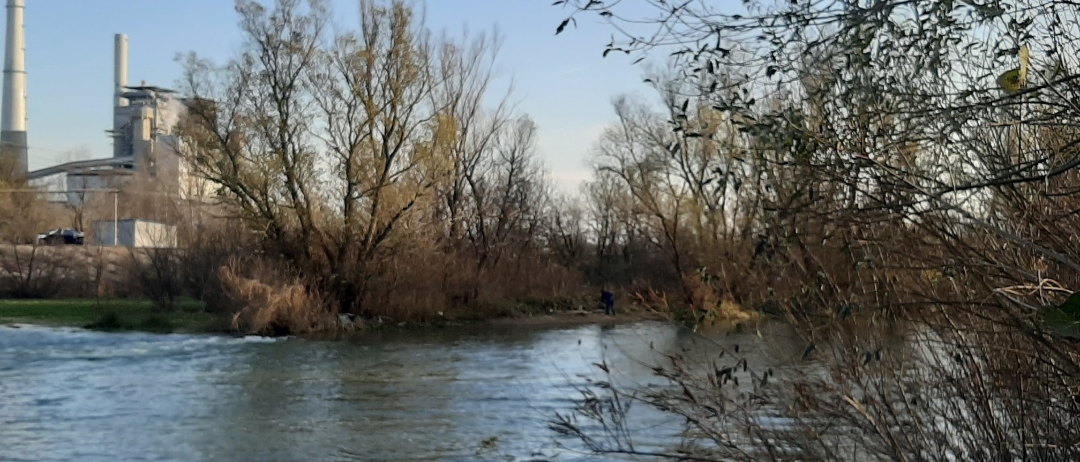Mlava on:
[Wikipedia]
[Google]
[Amazon]
The Mlava (
 In the lower part of the Mlava is divided into many parallel flows and causes frequent floods, and although many settlements are located near the river, none is on its shore. The villages near the Mlava are: Veliko Selo, Toponica, Kalište, Malo Crniće, Veliko Crniće, Salakovac, Trnjane, Nabrde, Bubushinac and Bradarac. In this part, in Mlava, its two largest tributaries are on the left side of the Chokordin and Vitovnica on the right. One Mlava trough runs for several kilometres near Pozarevac, where the river bed is 20–35 m wide and 1–3 m deep. Another trough, known as ''Mogila'', is 10–15 m wide and 0.5–1 m deep.
The last two settlements on the Mlace are the village Drmno and the town Kostolac. In both places there are
In the lower part of the Mlava is divided into many parallel flows and causes frequent floods, and although many settlements are located near the river, none is on its shore. The villages near the Mlava are: Veliko Selo, Toponica, Kalište, Malo Crniće, Veliko Crniće, Salakovac, Trnjane, Nabrde, Bubushinac and Bradarac. In this part, in Mlava, its two largest tributaries are on the left side of the Chokordin and Vitovnica on the right. One Mlava trough runs for several kilometres near Pozarevac, where the river bed is 20–35 m wide and 1–3 m deep. Another trough, known as ''Mogila'', is 10–15 m wide and 0.5–1 m deep.
The last two settlements on the Mlace are the village Drmno and the town Kostolac. In both places there are
 Warm Mlava (Topla Mlava) is a canal that connects Mlava (Wild Mlava) with the Danube east of the village of Selo Kostolac and west of the Kostolac B TPP. Its length is 4.3 km from the brush to the mouth, and from the yellow bridge (Viminacijum Bridge) to the intersection of 6.1 km. Its characteristics are warm water that comes out of the brush because of which there are plenty of fish and its biggest resident is pike and carp. The width is about 2 to 5 normal Mlava basins (70–175 m) and the depth is up to 4 m.
Warm Mlava (Topla Mlava) is a canal that connects Mlava (Wild Mlava) with the Danube east of the village of Selo Kostolac and west of the Kostolac B TPP. Its length is 4.3 km from the brush to the mouth, and from the yellow bridge (Viminacijum Bridge) to the intersection of 6.1 km. Its characteristics are warm water that comes out of the brush because of which there are plenty of fish and its biggest resident is pike and carp. The width is about 2 to 5 normal Mlava basins (70–175 m) and the depth is up to 4 m.
Serbian Cyrillic
The Serbian Cyrillic alphabet (, ), also known as the Serbian script, (, ), is a standardized variation of the Cyrillic script used to write the Serbian language. It originated in medieval Serbia and was significantly reformed in the 19th cen ...
: Млава) is a river
A river is a natural stream of fresh water that flows on land or inside Subterranean river, caves towards another body of water at a lower elevation, such as an ocean, lake, or another river. A river may run dry before reaching the end of ...
in Serbia
, image_flag = Flag of Serbia.svg
, national_motto =
, image_coat = Coat of arms of Serbia.svg
, national_anthem = ()
, image_map =
, map_caption = Location of Serbia (gree ...
, 158 km long right tributary of the Danube
The Danube ( ; see also #Names and etymology, other names) is the List of rivers of Europe#Longest rivers, second-longest river in Europe, after the Volga in Russia. It flows through Central and Southeastern Europe, from the Black Forest sou ...
.
Origin
Mlava originates as the ''Tisnica'', from the Kučaj mountains in eastern Serbia, under the ''Veliki Krš'' peak. It flows to the north and curves around the eastern slopes of the mountainBeljanica
Beljanica () is a mountains of Serbia, mountain in the Homolje region in eastern Serbia, near the town of Žagubica. Its highest peak has an elevation of 1,339 meters above sea level.
References
Mountains of Serbia
Serbian Carpathians
...
, through an almost uninhabited area. Reaching the Homolje
Homolje ( sr-Cyrl, Хомоље, ) is a small geographical regions of Serbia, region in east Serbia south of the Danube river. It is centered on the town of Žagubica, with smaller parts belonging to municipalities of Kučevo, Majdanpek and Petr ...
region, the Tisnica receives from the right a very powerful outflow of the karst well of Žagubičko vrelo (Žagubica well), at an altitude of 320 meters, and from that point the river is known as the Mlava. Measured from the Žagubičko vrelo, the river is 118 km long.
Upper course (Homolje region)
Originally, the Mlava flows to the northwest, but soon turns to the north, which is the general direction it follows for the rest of its course. It flows next to theŽagubica
Žagubica ( sr-cyr, Жагубица, ; or ) is a village and municipality located in the Braničevo District of the eastern Serbia. It is situated in the geographical region of Homolje. The population of the village is 2,110 while population o ...
, the main center of Homolje valley, and the villages of Izvarica (where it receives from the right the ''Jošanička reka''), Ribare, Sige and Ladne Vode.
In this section, the Mlava carved a long gorge, ''Gornjčako-ribarska klisura'' (Cyrillic: Горњачко-рибарска клисура; The gorge of Gornjak-Ribare), which begins at the Ribare, than it widens into the Krepoljin widening (where the large village of Krepoljin
Krepoljin is a village in the municipality of Žagubica, Serbia
, image_flag = Flag of Serbia.svg
, national_motto =
, image_coat = Coat of arms of Serbia.svg
, national_anthem = ()
, image_map ...
is located), and narrows again. Breaking through the ending part of the gorge at the village of Ždrelo, near the monastery of Gornjak, the Mlava leaves the Homolje for the Mlava region.
Middle course (Mlava region)
In this section, the Mlava valley widens, as the river flows next to the villages ofŠetonje
Šetonje is a village situated in Petrovac na Mlavi municipality in Serbia. Significant number of residents historically moved to Innsbruck in Austria
Austria, formally the Republic of Austria, is a landlocked country in Central Europe, ...
, Malo Laole, Veliko Laole, and reaches the town of Petrovac na Mlavi, the center of the whole Mlava region. It continues to the north, passes through the villages of Kamenovo, Trnovče and Rašanac and enters the hilly region of Stig.
Lower course (Stig region)
coal
Coal is a combustible black or brownish-black sedimentary rock, formed as rock strata called coal seams. Coal is mostly carbon with variable amounts of other Chemical element, elements, chiefly hydrogen, sulfur, oxygen, and nitrogen.
Coal i ...
and are located in the center of Kostolac basin. Mlava does not affect the main drainage of Danube
The Danube ( ; see also #Names and etymology, other names) is the List of rivers of Europe#Longest rivers, second-longest river in Europe, after the Volga in Russia. It flows through Central and Southeastern Europe, from the Black Forest sou ...
, but in Topla Mlava at a height of 65 meters, which is created by a brush from which the hot water from the lake (TE KOSTOLAC B canal) is released. In the rainy years, Wild Mlava spreads over 100 m while the normal width of that part of Mlava near Bradarac and Drmno is only 30–45 m, and the normal depth is about 1.5–3 m. Some geographers call this Wild Mlava system, while Warm Mlava is considered as the final part of the Mlava stream, until Mlava turns its old trough "Cold Mlava" (Donja Mogila), east of Kostolac.
Warm Mlava
 Warm Mlava (Topla Mlava) is a canal that connects Mlava (Wild Mlava) with the Danube east of the village of Selo Kostolac and west of the Kostolac B TPP. Its length is 4.3 km from the brush to the mouth, and from the yellow bridge (Viminacijum Bridge) to the intersection of 6.1 km. Its characteristics are warm water that comes out of the brush because of which there are plenty of fish and its biggest resident is pike and carp. The width is about 2 to 5 normal Mlava basins (70–175 m) and the depth is up to 4 m.
Warm Mlava (Topla Mlava) is a canal that connects Mlava (Wild Mlava) with the Danube east of the village of Selo Kostolac and west of the Kostolac B TPP. Its length is 4.3 km from the brush to the mouth, and from the yellow bridge (Viminacijum Bridge) to the intersection of 6.1 km. Its characteristics are warm water that comes out of the brush because of which there are plenty of fish and its biggest resident is pike and carp. The width is about 2 to 5 normal Mlava basins (70–175 m) and the depth is up to 4 m.
Characteristics
The drainage area of the Mlava covers 2,810 km2 and belongs theBlack Sea
The Black Sea is a marginal sea, marginal Mediterranean sea (oceanography), mediterranean sea lying between Europe and Asia, east of the Balkans, south of the East European Plain, west of the Caucasus, and north of Anatolia. It is bound ...
drainage area
A drainage basin is an area of land in which all flowing surface water converges to a single point, such as a river mouth, or flows into another body of water, such as a lake or ocean. A basin is separated from adjacent basins by a perimeter, th ...
.
Average annual discharge at the mouth is 34 m³/s.
References
* Jovan Đ. Marković (1990): ''Enciklopedijski geografski leksikon Jugoslavije''; Svjetlost-Sarajevo; * * ''Mala Prosvetina Enciklopedija'', Third edition (1985); Prosveta; {{commons category, Mlava Rivers of Serbia